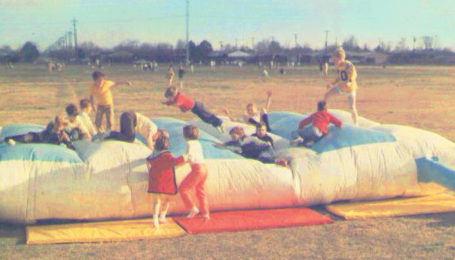Introduction: Bounce houses, those colorful and inflatable structures that bring joy to children and adults alike, have a fascinating history. These inflatable play structures have come a long way from their humble beginnings. In this blog post, we'll take a journey through time to explore the evolution of bounce houses, from their inception to their current popularity as a staple in parties and events.
The Early Days: The story of bounce houses begins in the 1950s, although not in the form we know today. In the beginning, they were not intended for entertainment but had a more practical purpose. Engineers and scientists were experimenting with inflatable structures for various applications, including military uses and safety devices.
The Invention of the Space Walk: In 1959, John Scurlock, an engineer from Shreveport, Louisiana, created the first inflatable structure called the "Space Walk." It was initially designed as a safety device to cushion falls and was made from a canvas top stretched over air cushions. The Space Walk laid the foundation for what would later become the modern bounce house.
Commercialization and Popularity: As the 1960s rolled in, the Inflatable Castle was commercialized, and bounce house rental companies started offering them for parties and events. They were popular at carnivals and fairs, providing a unique and exciting attraction for kids. Over time, the canvas tops were replaced with more durable materials, making them safer and more reliable.
The Transition to Vinyl: In the 1970s, the material used for bounce houses shifted from canvas to vinyl. This change greatly improved durability and allowed for vibrant colors and designs, enhancing their visual appeal. The vinyl material was also easier to clean and maintain, making it more suitable for rental businesses.
Expanding Designs: As bounce houses gained popularity, manufacturers began to diversify their designs. Themed Bounce Houses were born along with inflatable slides, obstacle courses, and interactive games. These additions made them even more appealing for a wide range of events, from birthday parties to corporate gatherings.
Safety Improvements: Throughout the years, safety standards for bounce houses continued to evolve. Innovations such as reinforced seams, secure anchor points, and safety netting were introduced to ensure the well-being of users. Today, commercial-grade bounce houses are designed with safety as a top priority.
Conclusion: From their origins as air cushions to the vast array of inflatable play structures available today, bounce houses have come a long way. They have transitioned from practical applications to becoming a source of endless fun and entertainment. As they continue to evolve and capture the imaginations of people young and old, Commercial Bounce Houses are likely to remain a cherished part of parties and events for generations to come.
So, the next time you see a colorful bounce house at a celebration, take a moment to appreciate the rich history behind this inflatable marvel that brings smiles and laughter to people of all ages.

